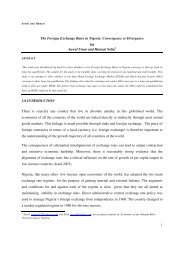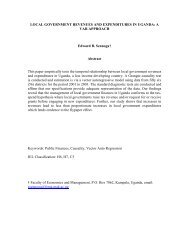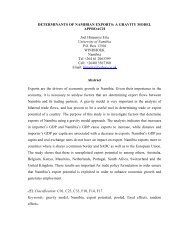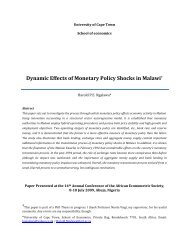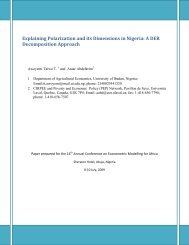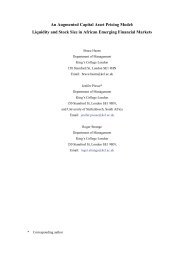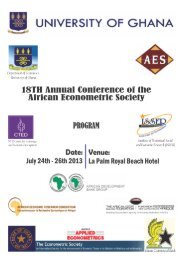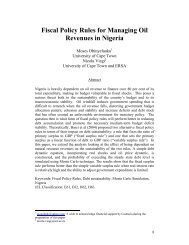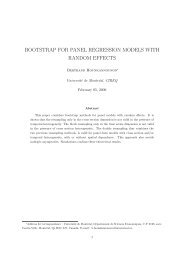The risk-return relationship in the South Africa stock market - African ...
The risk-return relationship in the South Africa stock market - African ...
The risk-return relationship in the South Africa stock market - African ...
You also want an ePaper? Increase the reach of your titles
YUMPU automatically turns print PDFs into web optimized ePapers that Google loves.
model and data is presented <strong>in</strong> section 3. Section 4 discusses <strong>the</strong> empirical results,while section 5 concludes.2 Literature reviewAssum<strong>in</strong>g rational, <strong>risk</strong>-averse <strong>in</strong>vestors, <strong>the</strong> Sharpe (1964) and L<strong>in</strong>tner (1965)Capital Asset Pric<strong>in</strong>g Model (CAPM) implies a positive, l<strong>in</strong>ear <strong>relationship</strong> between<strong>the</strong> expected <strong>market</strong> <strong>risk</strong> and <strong>return</strong>s. Merton (1973) estimated a variant of <strong>the</strong>traditional CAPM called <strong>the</strong> Intertemporal Capital Asset Pric<strong>in</strong>g Model (ICAPM).Similar to <strong>the</strong> CAPM, <strong>the</strong> ICAPM implies a positive, l<strong>in</strong>ear <strong>relationship</strong> between <strong>the</strong>aggregate <strong>market</strong> <strong>return</strong> and <strong>the</strong> <strong>market</strong> <strong>risk</strong> premium of <strong>the</strong> <strong>market</strong>. This assetpric<strong>in</strong>g model can be summarised by <strong>the</strong> follow<strong>in</strong>g equation:E JW ww2wftrm, t1 rf. t1 Etm,t1 Etmf , t1JwJw J [1] where E r r is <strong>the</strong> conditional <strong>market</strong> <strong>return</strong> between period t and t 1.t m, t1f , t1is <strong>the</strong> rate of <strong>return</strong> on <strong>the</strong> <strong>stock</strong> <strong>market</strong> <strong>in</strong>dex andE r t m, t1r f , t1is <strong>the</strong> rate of <strong>return</strong>on <strong>risk</strong>-free asset.E2t m , t 1is <strong>the</strong> conditional variance of <strong>the</strong> <strong>market</strong> <strong>return</strong> or <strong>the</strong> <strong>risk</strong>component.E is <strong>the</strong> covariance of <strong>the</strong> <strong>market</strong> <strong>return</strong> with <strong>in</strong>vestmenttmf , t1opportunities or <strong>the</strong> hedge component. W ( t 1)is wealth and F(t 1) is <strong>the</strong> vector ofstate variables that describe wealth such thatJ ( W ( t 1),F(t 1),t 1) is <strong>the</strong> <strong>in</strong>directutility function of wealth. JJwwwWis positive if <strong>in</strong>vestors are <strong>risk</strong> averse.is <strong>the</strong> measure of <strong>risk</strong> aversion or price of <strong>risk</strong> andAssum<strong>in</strong>g that <strong>in</strong>vestors have a recursive (power) utility function and <strong>the</strong> rates of<strong>return</strong> are <strong>in</strong>dependent and identically distributed, Merton (1980) agues that relative<strong>risk</strong> aversion is constant such that that <strong>the</strong> hedge component is negligible. Inparticular, Guo and Neely (2006) argue that <strong>in</strong>vestment opportunities are sluggish,such that <strong>the</strong>ir impact on <strong>stock</strong> <strong>return</strong>s is almost constant <strong>in</strong> <strong>the</strong> short term. Thismakes <strong>the</strong> case for <strong>the</strong> exclusion of <strong>the</strong> hedge component and <strong>the</strong> use of high2



